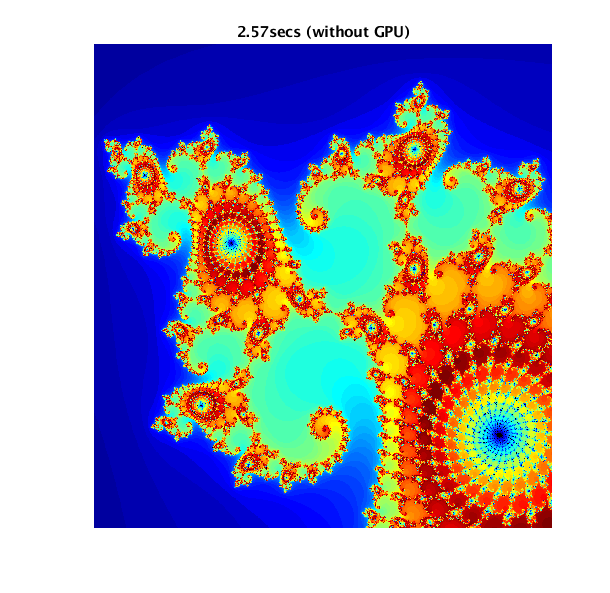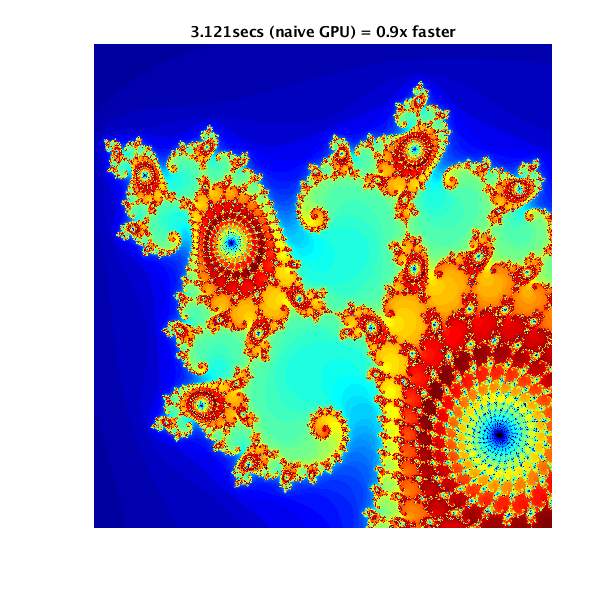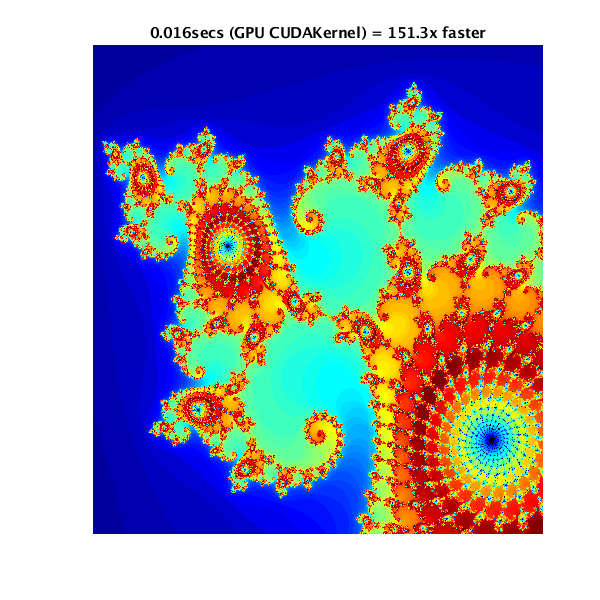MATLAB
MATLAB[1] is installed on Picotte. To use:[2]
module load matlab
(or the appropriate version string).
Installed versions are:
- Picotte: R20201a, R2020b, R2022b
Official Documentation
- Official documentation is online
Installed Toolboxes
To see the installed toolboxes, use the "ver" command within Matlab.
The Drexel Matlab license includes 33 toolboxes.[3]
Parallel Computing Toolbox
Picotte
t.b.a.
Proteus
To use the Parallel Computing Toolbox, you need to use the "matlab"
Parallel Environment. Detailed instructions are available in
$MATLABROOT/toolbox/distcomp/examples/integration/sge
Parallel jobs should use the "matlab" parallel environment. See below.
Using the Parallel Computing Toolbox consumes a license ("distrib_computing_toolbox"). See below.
MATLAB PATH and startup.m
By default, MATLAB includes ~/Documents/MATLAB in its search PATH. Any
startup commands may be placed in a file called startup.m in that
directory, i.e. ~/Documents/MATLAB/startup.m.
Interactive GUI Sessions
For both these cases, you must have the X11 software installed on your PC before you start.
Picotte
See: Running GUI Applications on Compute Nodes
Proteus
PROTEUS HAS BEEN RETIRED
If you require an interactive session on Matlab that uses more than 4 GB
of memory, you will need to request an interactive session using
qlogin or qsh. This is because the login nodes have
limitations on the amount of memory that any one user can consume, and
also limits on the number of CPU cores.
Please see Introduction to Using Proteus#Interactive Sessions. You can launch a terminal on the compute node, and run the GUI version of MATLAB:
[juser@proteusi01 ~]$ qrsh -pe shm 16 -l vendor=intel -l h_rt=1:00:00 -l h_vmem=4g /usr/bin/gnome-terminal
Once the terminal appears, the prompt should indicate the name of the compute node: something like ic11n03. Then, to run the MATLAB GUI:
[juser@ic11n03 ~]$ module load matlab
[juser@ic11n03 ~]$ matlab
GPU/CUDA Usage
The GPU Nodes on Picotte run CUDA 11.0.
The GPU Nodes on Proteus run CUDA 9.0, which is supported by MATLAB R2018a only. (R2018b requires CUDA 9.1.)
For more information, see:
- MATLAB Official Documentation - GPU Computing
- Loren on the Art of Matlab Blog - Using GPUs in Matlab
GPU Example
Mathworks has an example of usage of GPUs (CUDA), and possible pitfalls: https://www.mathworks.com/help/parallel-computing/examples/illustrating-three-approaches-to-gpu-computing-the-mandelbrot-set.html
The example computes and displays a Mandelbrot set in three ways:
- using CPU only
- using the GPU in a naive manner
- using the GPU via a CUDA kernel (the proper way to use a GPU)
In order, here are the results of the three different methods of computing the Mandelbrot set:



Job Scripts
Picotte Example
#!/bin/bash
#SBATCH --account=myrsrchPrj
#SBATCH --nodes=1
#SBATCH --ntasks=1
#SBATCH --cpus-per-task=16
#SBATCH --mem=128G
#SBATCH --time=1:00:00
module load matlab
# Your Matlab program is a file named myprog.m
matlab -nodisplay -nodesktop -nosplash -noFigureWindows -r myprog
### Equivalently
#matlab -nodisplay -nodesktop -nosplash -noFigureWindows < myprog.m
Proteus Example
Matlab computations must be run as non-interactive, non-displaying jobs. The proper way to do it in a job script is:
#!/bin/bash
#$ -S /bin/bash
#$ -M myemail@drexel.edu
#$ -j y
#$ -cwd
#$ -P myrsrchPrj
#$ -pe shm 16
#$ -jc matlab
#$ -l vendor=intel
#$ -l h_rt=1:00:00
#$ -l m_mem_free=3g
#$ -l h_vmem=4G
. /etc/profile.d/modules.sh
module load shared
module load sge/univa
module load proteus
module load matlab/R2018b
# Your Matlab program is a file named myprog.m
matlab -nodisplay -nodesktop -nosplash -noFigureWindows -r myprog
### Equivalently
#matlab -nodisplay -nodesktop -nosplash -noFigureWindows < myprog.m
Licenses
Matlab now is run with a site license not requiring checkouts. This license request is no longer necessary.
OBSOLETE Running Matlab consumes license seats. For jobs not
using any special toolboxes, just one base license is required:
#$ -l matlab=1
See below for more detail.
Number of Computation Threads - "Serial" Jobs
Matlab does not offer the user control over the number of threads of computation. Some testing has shown that it will use all CPU cores up 32.
Job Class
All Matlab jobs should not specify a PE request, and instead request the "job class" (jc) named "matlab":
#$ -jc matlab
Number of Slots
The number of slots can be read within Matlab by reading the environment variable NSLOTS:
n_slots = str2num(getenv("NSLOTS"))
This may be used for setting parpool size. See Parallel Execution below.
Reducing Memory Requirements
You may reduce memory requirements by not loading the Java Virtual Machine[4] This may also speed up the startup process.
Speeding Up Startup
MATLAB will run very slow if there are a lot of files (~10^5) in the same directory where the "matlab" command is given. If you have a lot of similar jobs to run, create a separate directory for each input, and make sure to run the "matlab" command from that directory. (Thanks to Y. Lan for figuring this out.)
For example, say you have a directory
/mnt/HA/groups/myresearchGrp/TonsOfData/ containing 1 million data
files to be processed. The obvious way of doing this, i.e. create a job
script and a Matlab script in that directory and do a qsub there, will
result in very slow running. You should create the job script and the
Matlab script elsewhere, in a directory not containing so many files,
and do the qsub there. Matlab can open files with a full path:
% open a file using a full (explicit) path
fileID = fopen('/mnt/HA/myresearchGrp/TonsOfData/file001.txt', 'r');
doMyAnalysis(fileID, par1, par2);
Checkpointing
To checkpoint a job is to save the job's state such that it can be
stopped and restarted at the checkpoint. This is especially important
for Monte Carlo computations which run a long time: there is a
possibility the compute node may crash, or fail in some other way. It is
also a way to fit into the 48-hour global wallclock (h_rt) limit.
Your Matlab script should write a file, probably separate from your normal job output, containing checkpoint data. Checkpoint data are all items required to re-start the computation from that point. This may include things like seed values.
Parallel Execution
Please refer to the official Matlab Documentation[5]
If you use
parpool, you
should set the pool size to be the number of slots requested:
% read NSLOTS from environment -- this environment variable is set by the job scheduler, Grid Engine
% see the article on Writing Job Scripts#Environment Variables
poolsize = str2num(getenv('NSLOTS'));
parpool(poolsize);
parfor
The use of parfor[6] on the Proteus cluster is tricky because it may
lead to "oversubscription", unless one is careful. Oversubscription is
when a computation (or set of computations, in this case) execute more
threads than there are physical CPU cores.
If you have independent computations which you want to run simultaneously, we suggest using an array job: see Writing Job Scripts#Array Jobs
Matlab's parfor uses a "pool" of CPU cores. Without the Matlab Parallel Server product, only local pools can be created. Parfor distributes computation to the CPU cores defined in a pool. If you run a job array, i.e. multiple tasks sharing one job ID each task on its own node, each task would create its own local parpool on its node.[7]
To use parfor, job- or task-specific local storage directories need to be set up. Matlab parfor stores state data and intermediate results in a subdirectory of your home directory. If multiple jobs are run simultaneously, the multiple jobs' parfor calls may overwrite each other's state data.
To make job- and task-specific local storage directories, you will need
to set up the JobStorageLocation. We recommend also to read the job
environment for the number of slots (CPU cores) for setting the number
of pool workers, rather than hard coding a literal number in the Matlab
code.
Each job that runs on Proteus has a node-local directory created for it
by Grid Engine. This directory is named by the job ID, task ID if
appropriate, and the queue name. This directory is also given by the
environment variable TMP. See Writing Job Scripts#Staging Work to Local Scratch
Here is brief example to set the JobStorageLocation for parfor, and also the number of pool workers:[8][9]
% create a local cluster object
pc = parcluster('local')
% explicitly set the cluster JobStorageLocation
pc.JobStorageLocation = getenv('TMP')
% start the pool
% the environment variable NSLOTS is exactly what is set in your PE request;
% e.g. "#$ -pe shm 12" means that NSLOTS = 12
poolobj = parpool(pc, str2num(getenv('NSLOTS')))
parfor i = 1:100
ones(10,10)
end
% once computation is done, delete the pool object
% optional as objects are deleted at end of program
delete(poolobj)
This should be done before any parfor calls are made, whether in code you have written or in libraries you are using. This should only be done once per program.
No changes need to be made to your job scripts or resource requests. The
TMP directory is automatically deleted by Grid Engine upon job end.
Details about how Matlab executes parallel jobs are documented in the online Matlab manual.[10]
Licenses
Matlab is now (Apr 2017) run with a site license which does not need individual license checkouts. No license resources need to be requested with Matlab jobs, any more.
OBSOLETE Running Matlab will consume licenses from the pool
provided by the Drexel site license. Drexel has unlimited seats for
Matlab and all toolboxes.
As an example, to run Matlab and use the Parallel Computing Toolbox (a.k.a. Distributed Computing Toolbox):
#$ -l matlab=1
#$ -l distrib_computing_toolbox=1
This is a list of the available Matlab and Matlab Toolbox licenses, along with the total available seats for use on Proteus:
| MATLAB Licenses | ||
|---|---|---|
| Resource String | Product | No. of Seats Avail. |
| matlab | MATLAB | 5325 |
| bioinformatics_toolbox | Bioinformatics Toolbox | 5325 |
| data_acq_toolbox | Data Acq Toolbox | 5325 |
| database_toolbox | Database Toolbox | 5325 |
| distrib_computing_toolbox | Parallel Computing Toolbox | 5325 |
| excel_link | Excel Link | 5325 |
| gads_toolbox | Global Optimization (GADS) Toolbox | 5325 |
| mpc_toolbox | Model Predictive Control (MPC) Toolbox | 5325 |
| virtual_reality_toolbox | Virtual Reality Toolbox | 5325 |
See the Licensed Software article for more information. Information about the Drexel MATLAB license is here.
Compiling with MEX
The default GCC 4.8.1 may not be compatible with the MATLAB version you select. See Matlab - Supported and Compatible Compilers for the latest release of Matlab
[juser@proteusi01 ~]$ module unload gcc
[juser@proteusi01 ~]$ gcc --version
gcc (GCC) 4.4.7 20120313 (Red Hat 4.4.7-16)
Copyright (C) 2010 Free Software Foundation, Inc.
This is free software; see the source for copying conditions. There is NO
warranty; not even for MERCHANTABILITY or FITNESS FOR A PARTICULAR PURPOSE.
In the same directory containing the source .c file, do the following:
[juser@proteusi01 MTIMESX]$ module load matlab/R2015b
[juser@proteusi01 MTIMESX]$ mex CFLAGS="-std=c99 -fPIC -O3" -DDEFINEUNIX -largeArrayDims -lmwlapack -lmwblas mtimesx.c
This produces a file named mtimesx.mexa64. Then, move the file the
your default MATLAB directory:
[juser@proteusi01 MTIMESX]$ mkdir -p ~/Documents/MATLAB
[juser@proteusi01 MTIMESX]$ mv mtimesx.mexa64 ~/Documents/MATLAB
And test it:
[juser@proteusi01 ~]$ matlab -nodisplay -nodesktop -nosplash
< M A T L A B (R) >
Copyright 1984-2015 The MathWorks, Inc.
R2015b (8.6.0.267246) 64-bit (glnxa64)
August 20, 2015
To get started, type one of these: helpwin, helpdesk, or demo.
For product information, visit www.mathworks.com.
Academic License
>> a = rand(4096);
>> b = rand(4096);
>> tic, c2 = mtimesx(a, b, 'speedomp'); toc
Elapsed time is 3.034698 seconds.
This example uses the MTIMESX package.
GPU/CUDA Support
- ~~With CUDA 6.0, only R2014b can be used~~ Proteus GPU nodes now all use CUDA 9
- With CUDA 9, R2018a or later can be used
See Also
- MathWorks MATLAB Central -- online community for MATLAB and SimuLink users
- Oxford University Advanced Research Computing: Running Matlab
- MathWorks Academic Resource Kit -- provides live support for installation and a user self-service resource kit for downloads, updates, and free tutorials. Or call IRT Desktop Support at 215.895.2020
References
[2] Environment Modules Quick Start Guide
[3] Drexel IRT - Matlab Toolbox Licensing
[4] MATLAB Documentation: Disabling Java VM on startup
[5] MATLAB Documentation: Specify Your Parallel Preferences
[6] MATLAB Documentation: Parallel for loops (parfor)
[7] MATLAB Documentation: parpool
[8] Univ. of Chicago Research Computing Center - MATLAB
[9] Stanford Univ. FarmShare wiki - Matlab-parallel
[10] Matlab Documentation: How Parallel Computing Products Run a Job